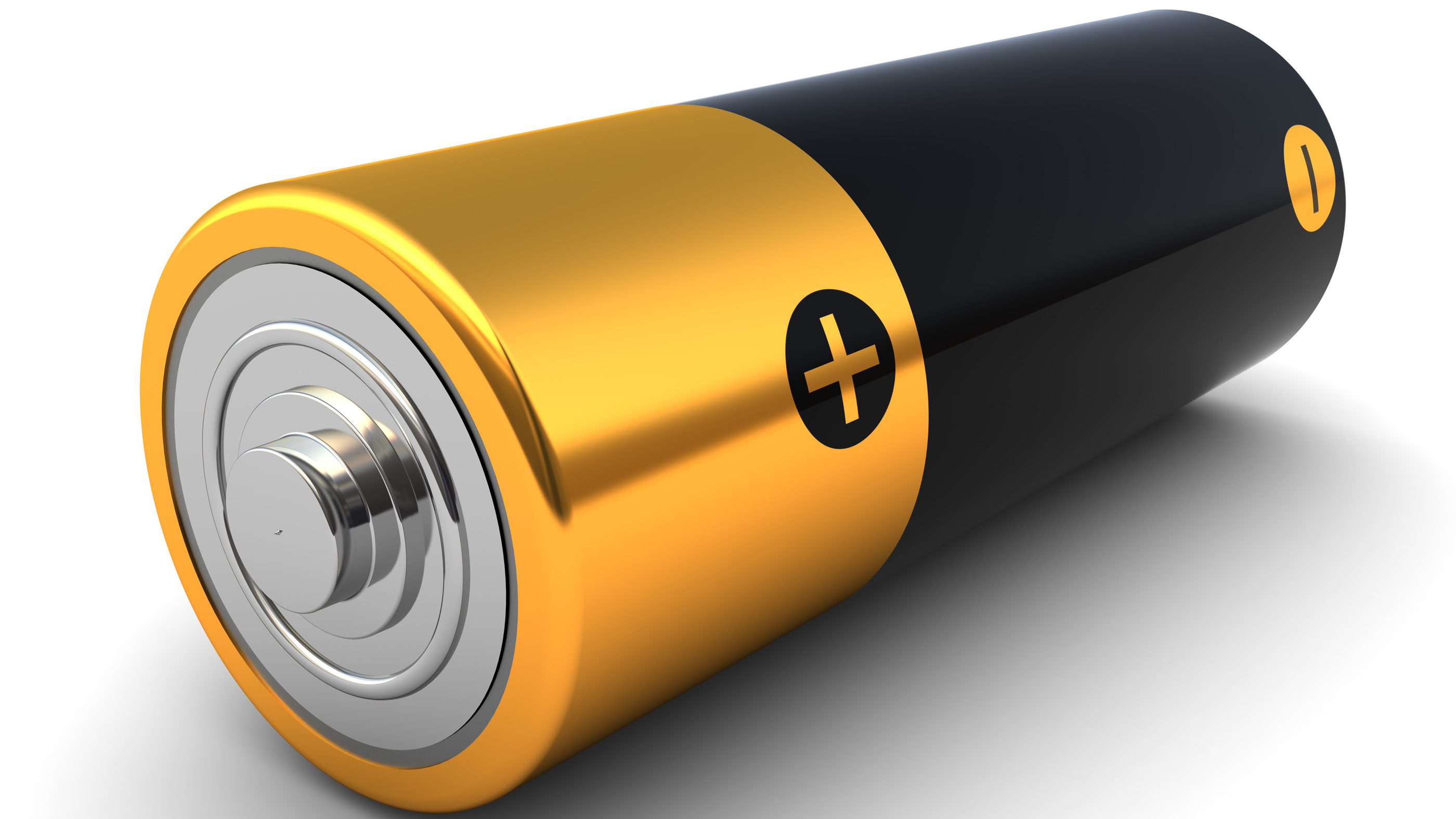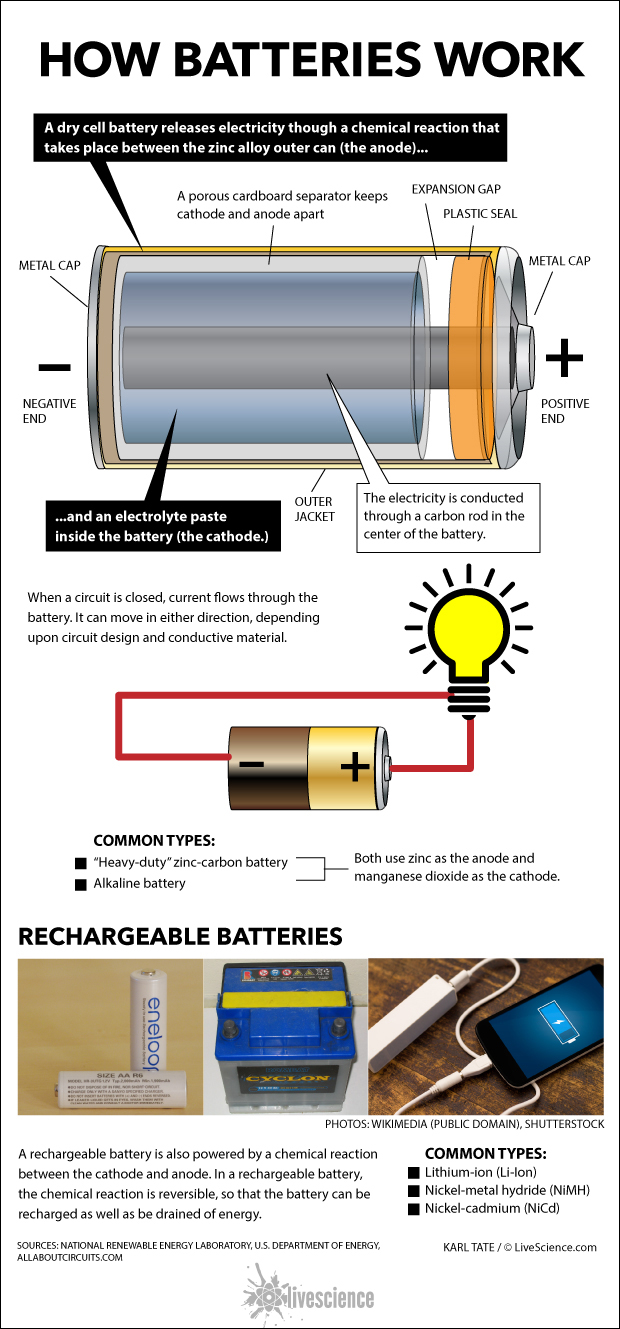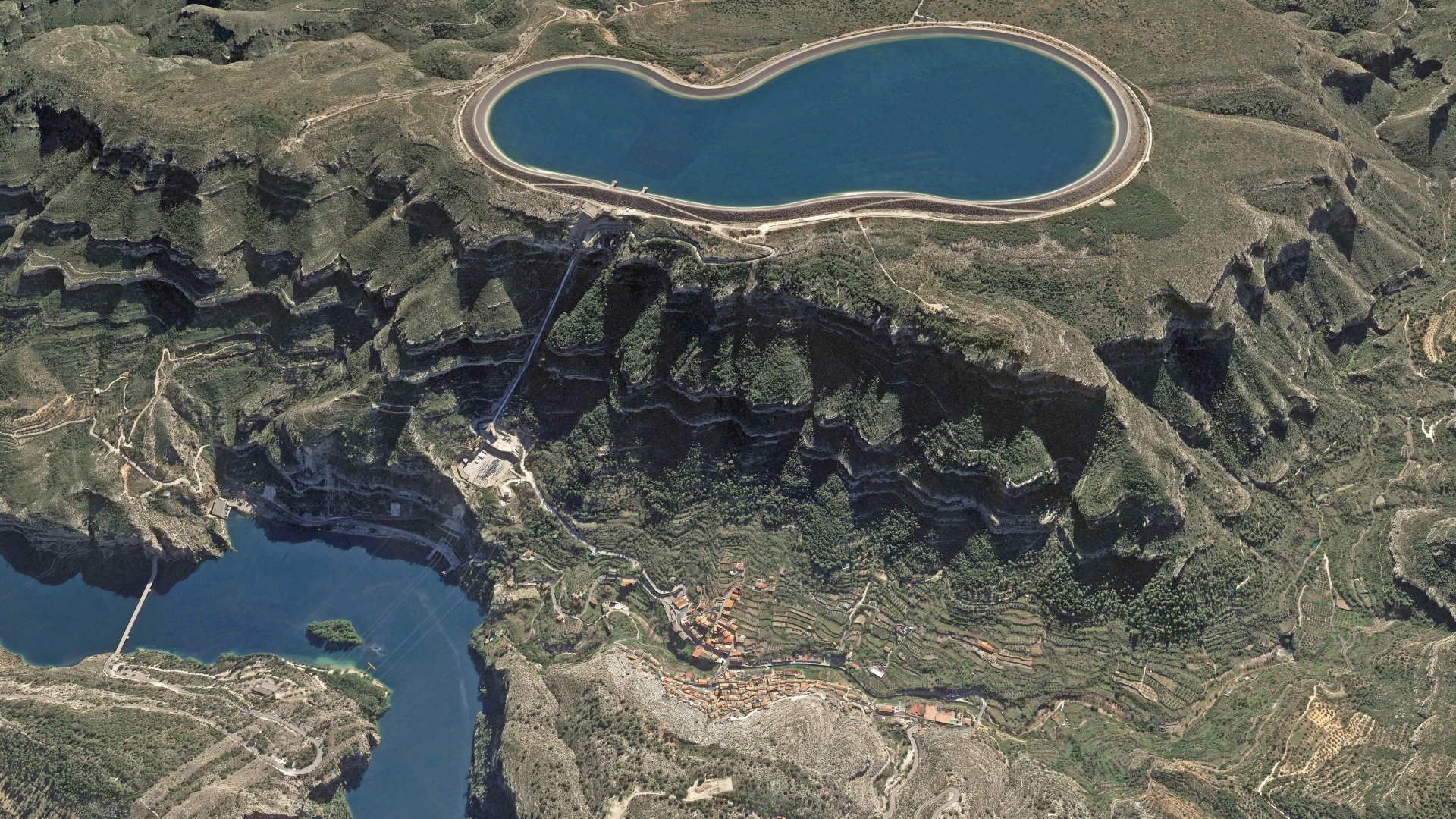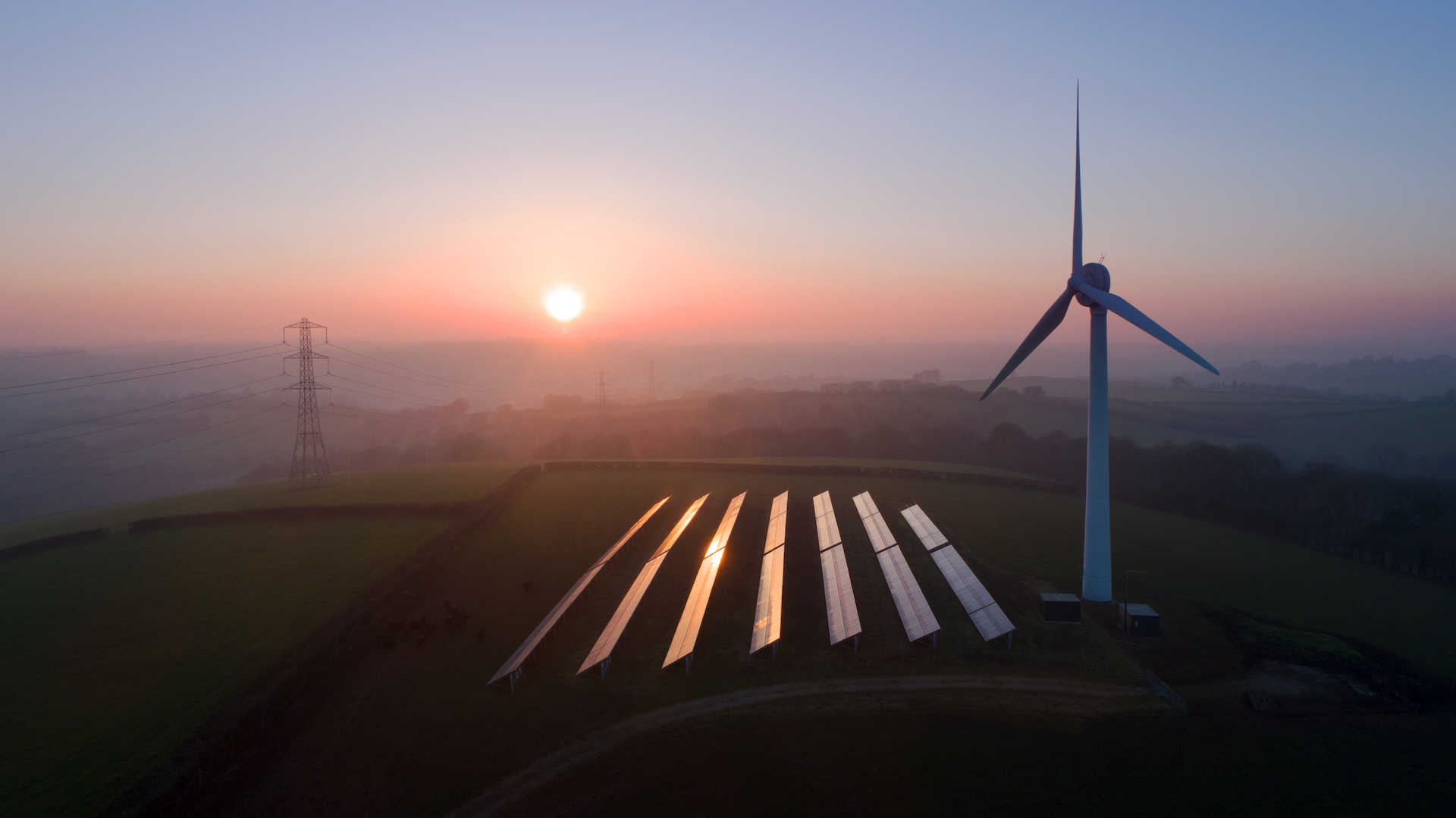How to store renewable energy
Storing renewable energy for a rainy day.

Renewable-energy storage is important to help humanity reduce its dependence on fossil fuels such as oil and coal, which produce carbon dioxide and other greenhouse gases that cause climate change.
Harnessing the power of the sun with solar panels and utilizing wind power with wind turbines are two common ways to generate renewable energy. But the sun isn't always shining and the wind isn't always blowing when we want electricity, and sometimes they produce surplus energy when demand is low.
To reduce the impact of inconsistent energy generation from renewable sources, scientists and engineers are developing ways to store excess energy for use when it's needed. There are many different ways energy can be stored, and new storage techniques are being developed and refined all the time. Here are some of the best and most promising methods for storing renewable energy.
Related: Tesla to the rescue? Elon Musk offers solution for Australian blackouts
1. Batteries

Batteries are probably the most familiar method of storing energy. Humans use batteries in all sorts of electrical devices, from smartphones to cars. The most popular batteries are lithium-ion batteries, which are used in small devices and also make up more than 90% of battery storage on the global electricity grid, according to the Environmental and Energy Study Institute in Washington, D.C., a non-profit organization that promotes sustainable energy.
The negative end of a battery is connected to an electrode called the anode and the positive end is connected to another electrode called the cathode. Electrolyte, a liquid substance of electrically charged ions inside the battery, combines with the material of the electrodes to produce a chemical reaction that generates an electrical current. In lithium-ion batteries, the anode and cathode store lithium, according to the U.S. Department of Energy. The electrolyte carries positively charged lithium-ions from the anode to the cathode to power something and vice versa when the battery is charged, which can be done using renewable energy.
Lithium-ion batteries have some disadvantages. For example, they become less efficient and more likely to fail over time, according to the Clean Energy Institute at the University of Washington. They are also expensive to produce on a large scale, and extracting the raw materials needed to make them has a negative environmental impact. Like most other energy-storage methods, batteries don't retain all the energy that is put in them; they have an efficiency of 85% to 95%, according to a 2020 report by the World Energy Council, a network of energy leaders promoting sustainable energy.
Related: 3 scientists win Nobel Prize in chemistry for developing the lithium-ion Battery

2. Pumped hydro energy storage

Pumped hydro energy storage, or pumped storage hydropower, uses two water reservoirs to store electricity. Excess energy is used to pump water from a lower reservoir to a higher reservoir. Then, when the electricity is needed, water in the higher reservoir is released to flow back down to the lower reservoir through turbines that generate electricity, according to a 2021 review of pumped hydro energy storage published in the journal Progress in Energy. Not all of the energy used to pump the water up is regained when it is released; hydro energy storage has an efficiency of about 75% to 85%, according to the 2020 World Energy Council report.
The largest pumped hydroelectric storage facility in the world is in Virginia and serves power to about 750,000 homes, according to the Environmental and Energy Study Institute. Pumped hydro energy storage systems are typically built into, or near, rivers alongside the production of hydroelectric energy. However, they can also be used using seawater from oceans. A pumped hydro energy storage system on Okinawa Island, Japan, pulls seawater out of the ocean and up a hill through a pipeline. The system then releases the water back down through the pipe to power turbines and generate electricity, according to the University of Strathclyde in Scotland.
Related: Hoover Dam reservoir reaches record-low water levels
3. Pumped thermal electricity storage

Pumped thermal electricity storage involves using electricity generated from renewable sources to heat gravel or another heat-retaining material inside an insulated tank. This heat can then be used to generate electricity when needed, according to a 2020 article in The Conversation by Antoine Koen, a doctoral candidate in pumped thermal energy storage, and Pau Farres Antunez, a researcher in energy storage, both at the University of Cambridge in England.
The method uses easily accessible materials such as gravel, so it can be set up almost anywhere. Pumped thermal electricity storage has an expected efficiency range of between 50% and 70%, according to a 2017 paper published in the journal Renewable and Sustainable Energy Reviews. This technology is still being developed. The first demonstration Pumped thermal electricity storage facility at Newcastle University in England demonstrated an efficiency of 65% in 2019, according to a 2020 study published in the journal Frontiers in Energy Research.
4. Gravity energy storage
A U.K. company called Gravitricity is developing a technology to take full advantage of gravity. The method uses electricity to lift weights on a winch, which are later released to turn an electricity generator, regaining most of the energy used to lift them. This equipment could be built in disused mine shafts to drop around 13,200 tons (12,000 metric tons) down a shaft more than 2,620 feet (800 meters) deep, The Guardian reported in 2019. The technology has a predicted efficiency of 80% to 90%, according to the Gravitricity website. Another gravity-based system uses excess power to pull trains up an incline before letting them roll back down to release the stored energy, Live Science previously reported. A company called Advanced Rail Energy Storage (ARES) is developing one of these systems in Nevada, according to the ARES website.
Related: How 139 countries could be powered by 100% renewable energy by 2050
5. Compressed air energy storage

Compressed air energy storage systems pump air into an underground chamber to increase pressure, which can be released on demand to power gas turbines, Live Science previously reported. More energy is produced if the plant burns natural gas in the high-pressure air, but this produces carbon dioxide emissions. This system can have an efficiency of between 70% and 89%, according to the 2020 World Energy Council report. There are at least two operational compressed air energy storage facilities. The first facility was established in Huntorf, Germany in 1978, and a second facility in Alabama has been in operation since 1991, according to a 2021 study in the journal Renewable and Sustainable Energy Reviews.
6. Hydrogen storage
Hydrogen is used as a form of chemical energy storage. Electricity is converted into hydrogen through a process called electrolysis, which breaks up water into its hydrogen and oxygen elements, according to the U.S. Department of Energy. The hydrogen can then be stored and used as fuel to generate electricity. Hydrogen can also be used to power hydrogen vehicles to reduce greenhouse gas emissions from transport.
Using hydrogen to store energy has an efficiency of 35% to 55%, according to the 2020 World Energy Council report. Hydrogen fuel cells are costly, as they require expensive metals such as platinum. However, they are used to power and backup critical facilities such as telecom relays and credit card processing, according to the Environmental and Energy Study Institute.
Related: 'Burning' hydrogen plasma in the world's largest laser sets fusion records
Additional resources
To learn more about how we can use renewable energy to power the world, watch this short YouTube video by TED-Ed. You can find out how to save money by conserving energy and fuel on the U.S. Department of Energy website. Read more about the benefits of renewable energy from the Union of Concerned Scientists, a science advocacy nonprofit.
Bibliography
Advanced Rail Energy Storage, "ARES Nevada Project," 2022. https://aresnorthamerica.com/nevada-project/
Alexandra Zablocki, Environmental and Energy Study Institute, "Energy Storage (2019)," Feb. 22, 2019. https://www.eesi.org/papers/view/energy-storage-2019
Antoine Koen and Pau Farres Antunez, The Conversation, "How heat can be used to store renewable energy," Feb. 25, 2020. https://theconversation.com/how-heat-can-be-used-to-store-renewable-energy-130549
Blakers et al. "A review of pumped hydro energy storage," Progress in Energy, Volume 3, March 25, 2021. https://iopscience.iop.org/article/10.1088/2516-1083/abeb5b
Clean Energy Institute, University of Washington, "Lithium-ion battery," 2020. https://www.cei.washington.edu/education/science-of-solar/battery-technology/
Davenne, T. R. and Peters, B. M. "An analysis of pumped thermal energy storage with de-coupled thermal stores," Frontiers in Energy Research, Volume 8, Aug. 11, 2020. https://www.frontiersin.org/articles/10.3389/fenrg.2020.00160/
Department of Mechanical & Aerospace Engineering, University of Strathclyde, "Seawater pumped hydro storage." http://www.esru.strath.ac.uk/EandE/Web_sites/17-18/cumbrae/Seawater%20pumped%20hydro.html
Elizabeth Palermo, Live Science, "How Do Batteries Work?" April 29, 2015. https://www.livescience.com/50657-how-batteries-work.html
Gravitricity, "Fast, long-life energy storage." https://gravitricity.com/technology/
Jillian Ambrose, The Guardian, "How UK's disused mine shafts could be used to store renewable energy," Mon. 21, 2019. https://www.theguardian.com/environment/2019/oct/21/how-uks-disused-mine-shafts-plan-to-store-renewable-energy
Jim Park, Clayton Ashley and Dave Brody, Live Science, "Renewable Energy Rides the Rails to More Efficient Power Storage," Feb. 07, 2014. https://www.livescience.com/43211-renewable-energy-rides-the-rails-to-more-efficient-power-storage.html
King et al. "Overview of current compressed air energy storage projects and analysis of the potential underground storage capacity in India and the UK," Renewable and Sustainable Energy Reviews, Volume 139, April 2021. https://www.sciencedirect.com/science/article/pii/S1364032121000022
Michael Schirber, Live Science, "How Compressed Air Could Power the Future," June 04, 2008. https://www.livescience.com/4955-compressed-air-power-future.html
Office of Energy Efficiency & Renewable Energy, U.S. Department of Energy, "How Does a Lithium-ion Battery Work?" Sep. 14, 2017. https://www.energy.gov/eere/articles/how-does-lithium-ion-battery-work
Office of Energy Efficiency & Renewable Energy, U.S. Department of Energy, "Hydrogen Production: Electrolysis." https://www.energy.gov/eere/fuelcells/hydrogen-production-electrolysis
Steinmann, W. D. "Thermo-mechanical concepts for bulk energy storage," Renewable and Sustainable Energy Reviews, Volume 75, Aug. 2017. https://www.sciencedirect.com/science/article/pii/S1364032116307341?via%3Dihub
World Energy Council, "Five Steps To Energy Storage: Innovation Insights Brief," 2020. https://www.worldenergy.org/assets/downloads/Five_steps_to_energy_storage_v301.pdf
Sign up for the Live Science daily newsletter now
Get the world’s most fascinating discoveries delivered straight to your inbox.

Patrick Pester is the trending news writer at Live Science. His work has appeared on other science websites, such as BBC Science Focus and Scientific American. Patrick retrained as a journalist after spending his early career working in zoos and wildlife conservation. He was awarded the Master's Excellence Scholarship to study at Cardiff University where he completed a master's degree in international journalism. He also has a second master's degree in biodiversity, evolution and conservation in action from Middlesex University London. When he isn't writing news, Patrick investigates the sale of human remains.










